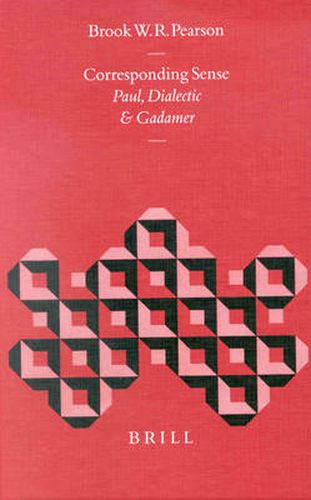Readings Newsletter
Become a Readings Member to make your shopping experience even easier.
Sign in or sign up for free!
You’re not far away from qualifying for FREE standard shipping within Australia
You’ve qualified for FREE standard shipping within Australia
The cart is loading…






Following the example of Hans-Georg Gadamer’s philosophical hermeneutics , this title treats several different problems in New Testament interpretation centred around the figure of Paul. In so doing, it demonstrates how a dialogical approach to the interpretation of ancient texts functions pragmatically to allow for a deeper understanding not only of individual texts, but also of their siting with the larger dialectical web of the texts and contexts of the ancient world. This approach, developed here in connection with the New Testament, also has relevance to other literature. In Corresponding Sense , Pearson outlines what he calls a dialectical topography - the tracing of connections and disjunctions between texts and their subject matter both within and outside of the New Testament. He uses both theoretical and practical discussion to demonstrate this approach, showing how it functions as a new way of approaching a Paul who is a member of a much larger community than simply the Judaism of his fathers - a Paul who participates in cultural narratives which extend throughout not only earliest Christianity, but also into the wider thought-world of the Roman Empire. This study is of particular use to those interested in the study of Paul, as well as those who, from a philosophical or pragmatic point-of-view, are concerned with the idea of what it means to interpret communication from another human being.
$9.00 standard shipping within Australia
FREE standard shipping within Australia for orders over $100.00
Express & International shipping calculated at checkout
Following the example of Hans-Georg Gadamer’s philosophical hermeneutics , this title treats several different problems in New Testament interpretation centred around the figure of Paul. In so doing, it demonstrates how a dialogical approach to the interpretation of ancient texts functions pragmatically to allow for a deeper understanding not only of individual texts, but also of their siting with the larger dialectical web of the texts and contexts of the ancient world. This approach, developed here in connection with the New Testament, also has relevance to other literature. In Corresponding Sense , Pearson outlines what he calls a dialectical topography - the tracing of connections and disjunctions between texts and their subject matter both within and outside of the New Testament. He uses both theoretical and practical discussion to demonstrate this approach, showing how it functions as a new way of approaching a Paul who is a member of a much larger community than simply the Judaism of his fathers - a Paul who participates in cultural narratives which extend throughout not only earliest Christianity, but also into the wider thought-world of the Roman Empire. This study is of particular use to those interested in the study of Paul, as well as those who, from a philosophical or pragmatic point-of-view, are concerned with the idea of what it means to interpret communication from another human being.